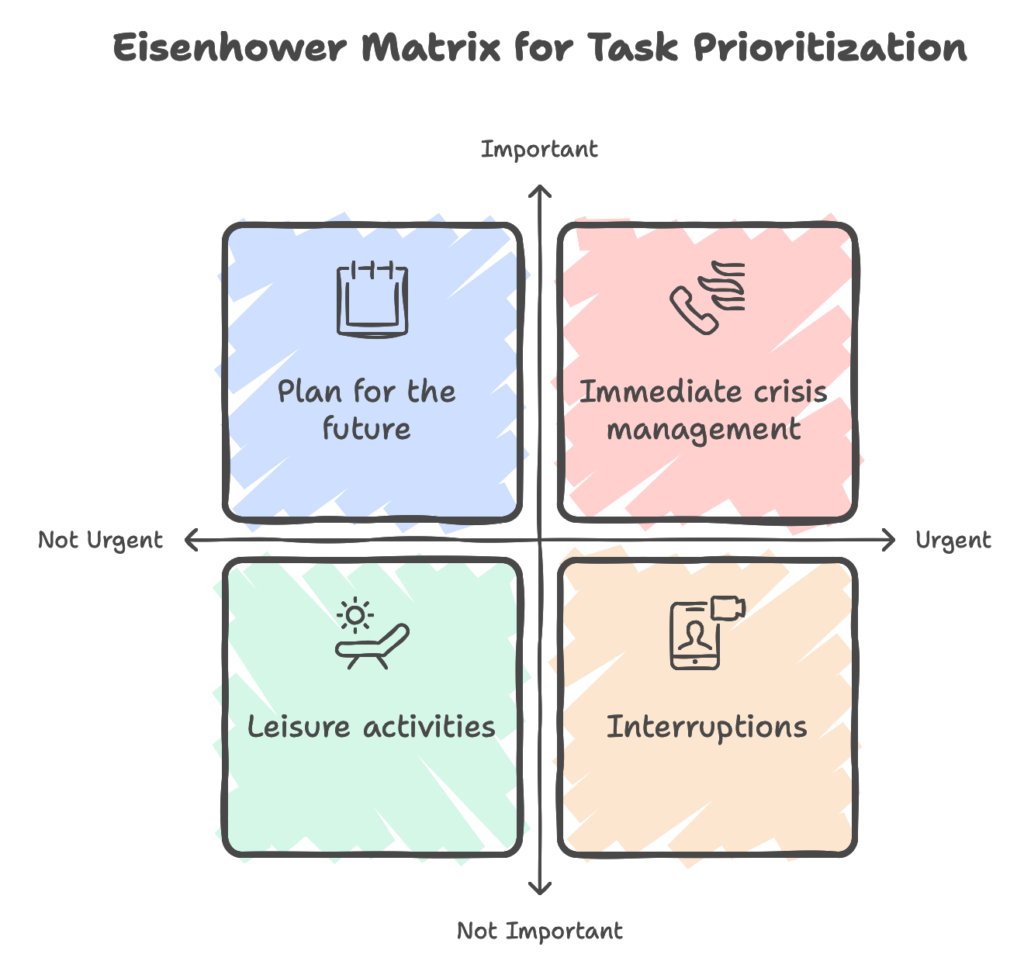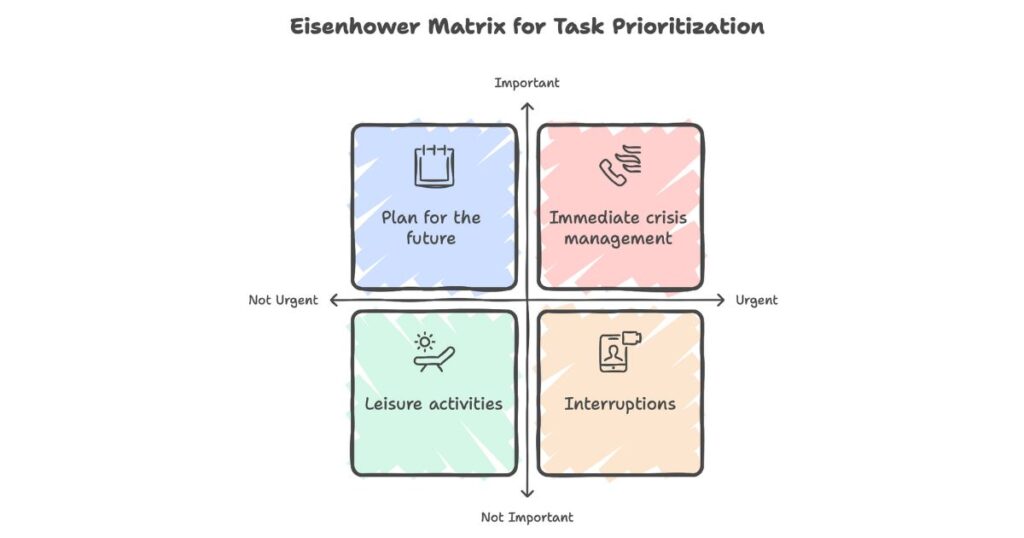Do you often find yourself overwhelmed by the many tasks demanding your attention? With deadlines looming and responsibilities piling up, it can be tough to decide what to prioritize. This is where the Eisenhower Matrix comes in—a simple yet effective tool for managing your time and tasks.
Why to Use This Tool:
The matrix helps you distinguish between what’s urgent and what’s important, allowing you to focus on the right things. Why is this crucial? Because not all tasks are created equal. Some may feel urgent but aren’t truly important, while others are essential but may not have immediate deadlines. By categorizing your tasks using the Eisenhower Matrix, you can work smarter, reduce stress, and ultimately achieve your goals more efficiently.
How to Use This Tool:

1. Draw the Matrix:
Start by drawing a large square and dividing it into four quadrants. Label them:
- Quadrant I: Urgent and Important
- Quadrant II: Important but Not Urgent
- Quadrant III: Urgent but Not Important
- Quadrant IV: Not Urgent and Not Important
2. List Your Tasks:
Take a moment to write down all the tasks you need to complete. Don’t hold back—include everything that’s on your mind.
3. Categorize Your Tasks:
- Quadrant I: Place tasks that are both urgent and important here (e.g., meeting deadlines, emergencies).
- Quadrant II: Place tasks that are important but not urgent here (e.g., long-term projects, relationship building).
- Quadrant III: Place tasks that are urgent but not important here (e.g., certain emails or calls that demand immediate attention but don’t contribute significantly to your goals).
- Quadrant IV: Place tasks that are neither urgent nor important here (e.g., mindless scrolling on social media, unnecessary meetings).
4. Take Action:
- Quadrant I: Do these tasks immediately.
- Quadrant II: Schedule time to work on these tasks—these are your opportunities for growth.
- Quadrant III: Delegate these tasks if possible, or set aside specific times to address them.
- Quadrant IV: Limit or eliminate these tasks to free up your time for what truly matters.
Real-life Implementation:
Meet Alex, a high school teacher juggling lesson plans, grading papers, and managing after-school activities. Every day felt like a race against the clock, and he often found himself working late into the night. Frustrated and exhausted, Alex discovered the Eisenhower Matrix through a productivity workshop.
Excited to give it a try, he drew the matrix on a large whiteboard in his classroom. After listing his tasks, Alex carefully categorized them. To his surprise, he realized that many of his after-school meetings fell into Quadrant III—urgent but not important. They felt pressing, but they didn’t significantly contribute to his main goals as a teacher.
With this newfound clarity, Alex started delegating certain responsibilities to student helpers and colleagues, freeing up valuable time for planning engaging lessons (Quadrant II). He also limited his time spent on social media (Quadrant IV), finding he had more time to dedicate to what he loved—teaching.
Over the next few weeks, Alex noticed a significant decrease in his stress levels. By focusing on what truly mattered, he became a more effective teacher and was able to connect better with his students.
Template Framework:
Here’s a practical template for using the Eisenhower Matrix in your daily life:
1. Draw Your Matrix:
Create a 2×2 grid on paper, a whiteboard, or a digital note app.
2. List Your Tasks:
Spend 5-10 minutes writing down everything you need to do this week.
3. Categorize Your Tasks:
Review your list and place each task in the appropriate quadrant:
- Quadrant I: Urgent and Important
- Quadrant II: Important but Not Urgent
- Quadrant III: Urgent but Not Important
- Quadrant IV: Not Urgent and Not Important
4. Plan Your Actions:
For each quadrant:
- Quadrant I: Do it now.
- Quadrant II: Schedule it.
- Quadrant III: Delegate it.
- Quadrant IV: Minimize or eliminate it.
5. Reflect Weekly:
At the end of the week, reflect on what worked and what didn’t. Adjust your approach as needed to continue improving your time management.
By using the Eisenhower Matrix, you can take charge of your tasks, reduce overwhelm, and focus on what truly matters in your life. So why not give it a try? Your productivity—and peace of mind—will thank you!
